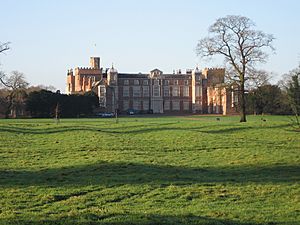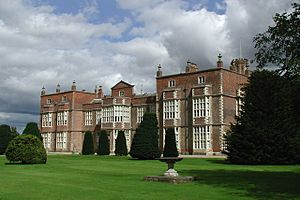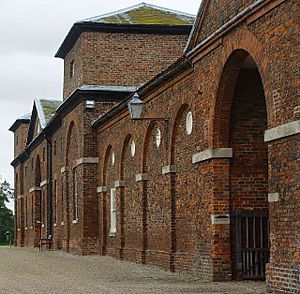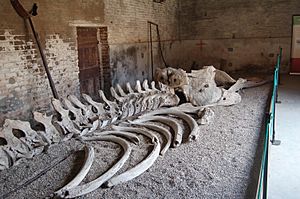Burton Constable Hall facts for kids
Burton Constable Hall is a huge country house in England. It was built during the Elizabethan period (when Queen Elizabeth I ruled). Inside, you can see designs from the 1700s and 1800s. The house also has a special collection of interesting objects called a "cabinet of curiosities".
This amazing hall is a Grade I listed building. This means it's a very important historic building. It sits in a big park that was designed by a famous landscape artist, Capability Brown. The park is about 300 acres (1.2 square kilometers) big. You can find Burton Constable Hall about 3 miles (5 km) south-east of Skirlaugh village. It's also about 9 miles (14 km) north-east of the city of Hull. The Constable family has lived here for over 400 years! Today, the Burton Constable Foundation, a charity, owns and looks after the hall and its park.
Contents
History of Burton Constable Hall
Even though Burton Constable Hall looks like it was built all at once, it has a long and interesting history. The oldest part of the house is the bottom of the north tower. It's made of limestone and dates back to the 1100s. Back then, it was a medieval pele tower. This tower helped protect the village of Burton Constable during the time of King Stephen.
In the late 1400s, a new brick manor house was built here. It eventually became the main home for the Constable family. Then, in the 1560s, Sir John Constable started building the grand Elizabethan house you see today. He used parts of the older manor house. He also added a new section with a Great Hall. This hall was very tall and had a special window at the top for light. There were also a Parlour, Chambers, and a South Wing added.
Remodelling the House in the 1760s
By the 1700s, the Great Hall probably looked a bit old-fashioned. Around 1730, Cuthbert Constable planned to update the inside of the house. But the big changes didn't happen until the 1760s. His son, William Constable, hired several architects to create new designs. These included famous names like John Carr and Capability Brown.
The beautiful plasterwork inside was done by James Henderson of York. William Constable also bought plaster statues of Demosthenes (a famous speaker) and Hercules (a hero). He also got plaster busts of the Roman emperor Marcus Aurelius Antoninus and the Greek poet Sappho. Above the fireplace, you can see a carving of oak branches and laurel leaves. It has the Garter Star and the Constable family's shield. This shield was made using a special material called scagliola by Domenico Bartoli.
The dining room was also greatly changed by William Constable in the 1760s. He asked Robert Adam, Thomas Atkinson, and Timothy Lightoler for designs. Lightoler won the job. The ceiling design was inspired by discoveries at Pompeii and Herculaneum. Giuseppe Cortese created the plasterwork. Above the fireplace, there's a plaque of Bacchus and Ariadne riding a panther. This was based on famous old carvings. The dining room was decorated again in the 1800s.
The Long Gallery
The long gallery is a long room on the upper floor, along the west side of the house. It was finished by the late 1500s. In 1610, Dame Margaret Constable was allowed to "walke at her pleasure" in this gallery. Back then, it probably didn't have much furniture.
The wooden panels in the gallery are from the late 1600s. The marble fireplace is also from that time. In the 1740s, Cuthbert Constable added the elm and mahogany bookcases. The ceiling and the decorative strip (frieze) have neo-Jacobean plasterwork from the 1830s. In 1833, the Clifford-Constable family started restoring the Long Gallery. They even bought special sphinx tables with marble tops.
Museum Rooms and Collections
We know that a museum existed in the house in 1774. But its exact location was a mystery for a while. In 1791, it was called the "White room adjoining Gallery." It held many framed drawings. The rooms that are now the Museum Rooms were once two bedrooms and a dressing room in 1775.
By the 1850s, a fancy theatre was created in this area. The outer room was for the audience, and the inner room was the stage. The Museum Rooms you see today were created in the 1970s. This is when William Constable's old science collections were found. They had been stored in the attics since the early 1800s.
The museum now shows part of a very large "Cabinet of Curiosities." This is a collection of strange and interesting objects. In 2003, the Burton Constable Foundation bought an 18th-century telescope. It had been in the house for about 200 years before being sold around 1960. William Constable bought it from a famous clockmaker, Henry Hindley, in 1760 for £105. It is thought to be the world's first telescope that could easily track stars as the Earth rotated.
The Chinese Room
The Chinese Room was inspired by visits to Brighton Pavilion in the 1830s. Marianne, Lady Clifford-Constable, and her sister Eliza visited there. The woodworker Thomas Brooks carved the gold dragons in the room. Marianne herself designed the dragon chair. Thomas Wilkinson Wallis carved it in 1841 while he was still learning his trade.
Grounds and Park
Before the deer park was made in 1517, the land was used for farming. A survey from 1621 shows that the park had many enclosed areas. The main entrance to the house was from the east, through a long path. An old moat stretched around two sides of the hall. To the west, there were three long, narrow fish ponds.
In 1715, a lot of work was done to level the land for new gardens. A lawn was probably created on the west side of the house. To the north, there was a group of trees with paths arranged in a pattern. In 1757, William Constable asked Thomas Knowlton for advice. Knowlton was the head gardener of the Londesborough Estate. He suggested a menagerie (a place for animals) at the north end of the lakes. This menagerie is now a Grade II* listed building. He also suggested a stove garden near the house, which had a greenhouse 62 meters (203 feet) long.
Lancelot "Capability" Brown worked on the park's landscape between 1772 and 1782. He connected the ponds to create two lakes, separated by a dam that also served as a bridge. He planted groups of trees and added special fences that were hidden in the ground (called sunk fences and ha-has). Burton Constable is one of Brown's best-documented projects. Notes from his eight visits and his instructions were written down by the estate manager, John Raines. These notes are called "Hints from Mr. Brown" or "Mr Brown's Directions". They were put online in 2016 for the Capability Brown Festival. This festival celebrated 300 years since his birth.
The old Elizabethan stable block next to the house was taken down. In its place, Lightoler built new Palladian-style stables in 1768. These stables were also made a Grade I listed building in 1966. Closer to the house, a new Orangery was finished in 1782. Thomas Atkinson designed it, and Eleanor Coade supplied the artificial stone decorations. This Orangery was listed as Grade II* in 1966.
The Whale Skeleton
An unusual sight in the park during the 1800s was the skeleton of an 18-meter (59 ft) long sperm whale. It was set up on iron supports. This male whale got stuck on the shore at nearby Tunstall in 1825. A famous surgeon from Hull, James Alderson, carefully studied and took apart the whale.
The whale skeleton was brought to Burton Constable. This was because Sir Clifford, as the Lord of Holderness, was allowed to claim anything interesting that washed up on the coast. This famous whale even caught the attention of Herman Melville. He wrote about it in his famous book Moby-Dick in 1851. He wrote that Sir Clifford's whale could be opened and shut like a "great chest of drawers." He even joked that Sir Clifford might charge people to see inside the whale's spine or hear echoes in its head!
You can still see the whale skeleton at Burton Constable Hall today, in the Great Barn.






